RGB-подсветка
Благодаря яркой и качественной RGB-подсветке, игровая сборка в корпусе HAF 500 выглядит интересно и привлекательно.
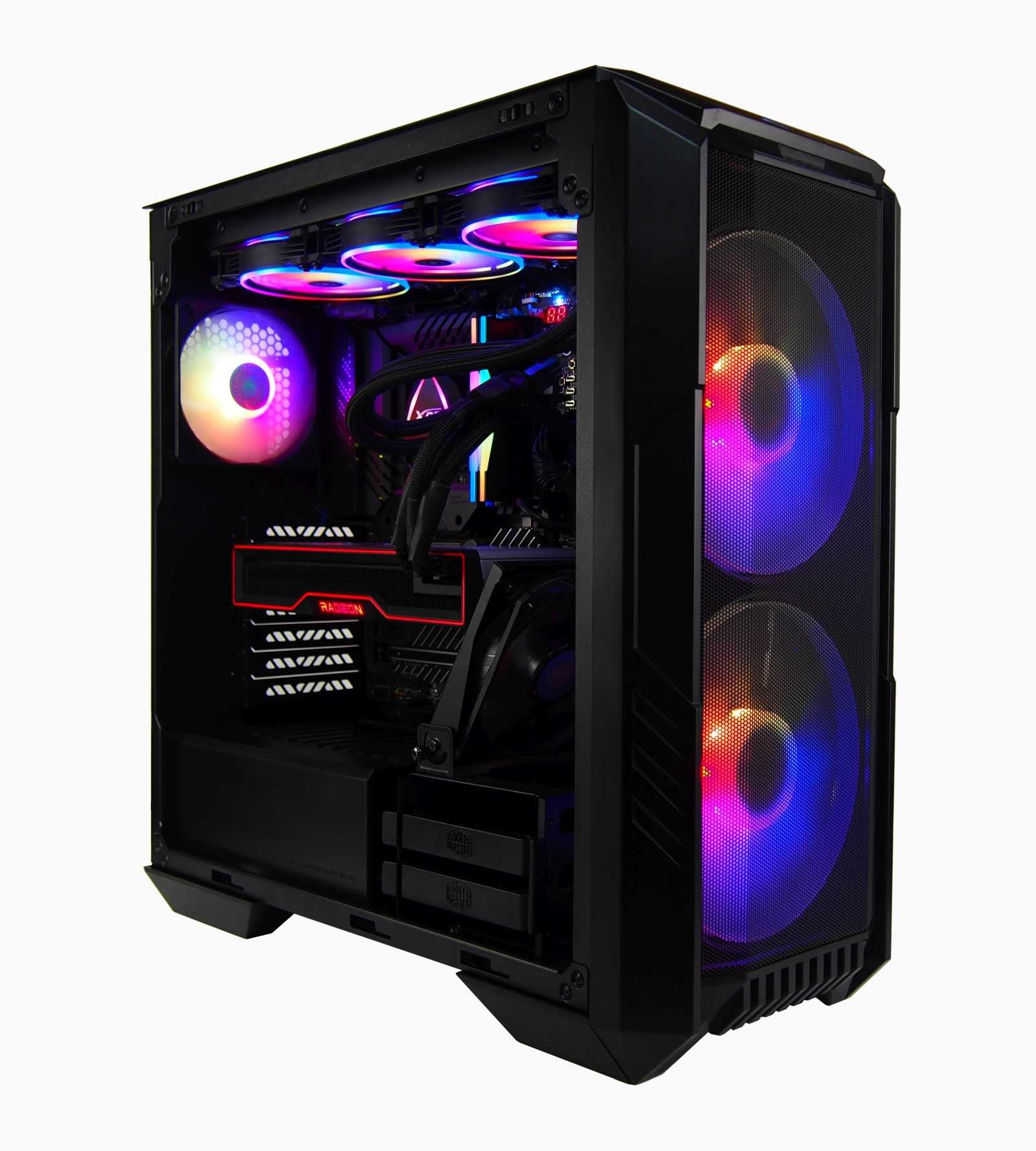


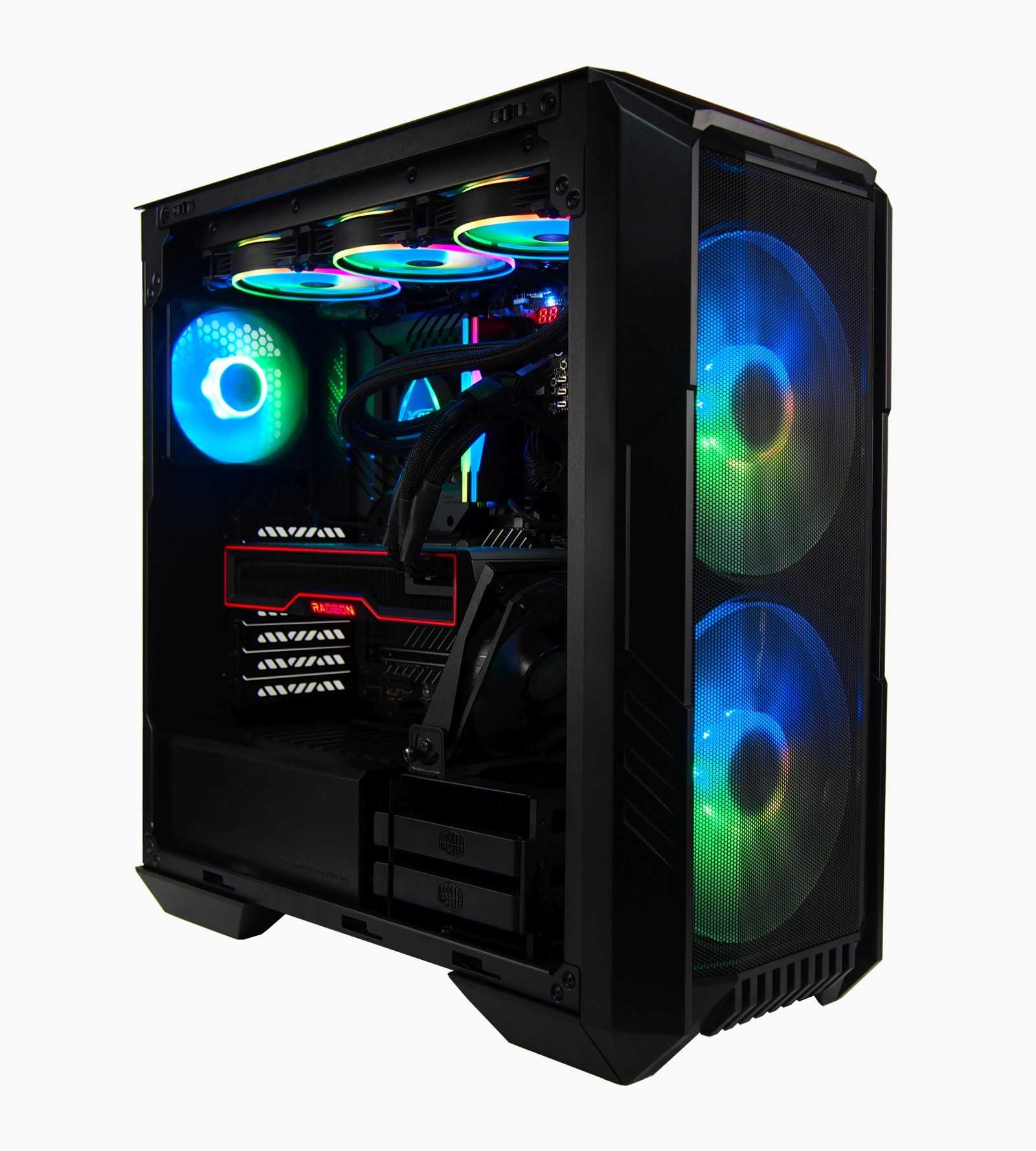
Установка панели из закаленного тонированного стекла не портит картину сборки. Наоборот, придает особенный внешний вид комплектующим, установленным в систему.

Что же касается визуальной составляющей фронтальных 200-мм вертушек, то они неплохо просматриваются даже через металлическую сетчатую преграду. Конечно, это не прозрачная стеклянная панель, как бывает в других кейсах. Но зато такое решение обеспечивает одновременно и продуваемость корпуса внутри, и видимость подсветки внешне.
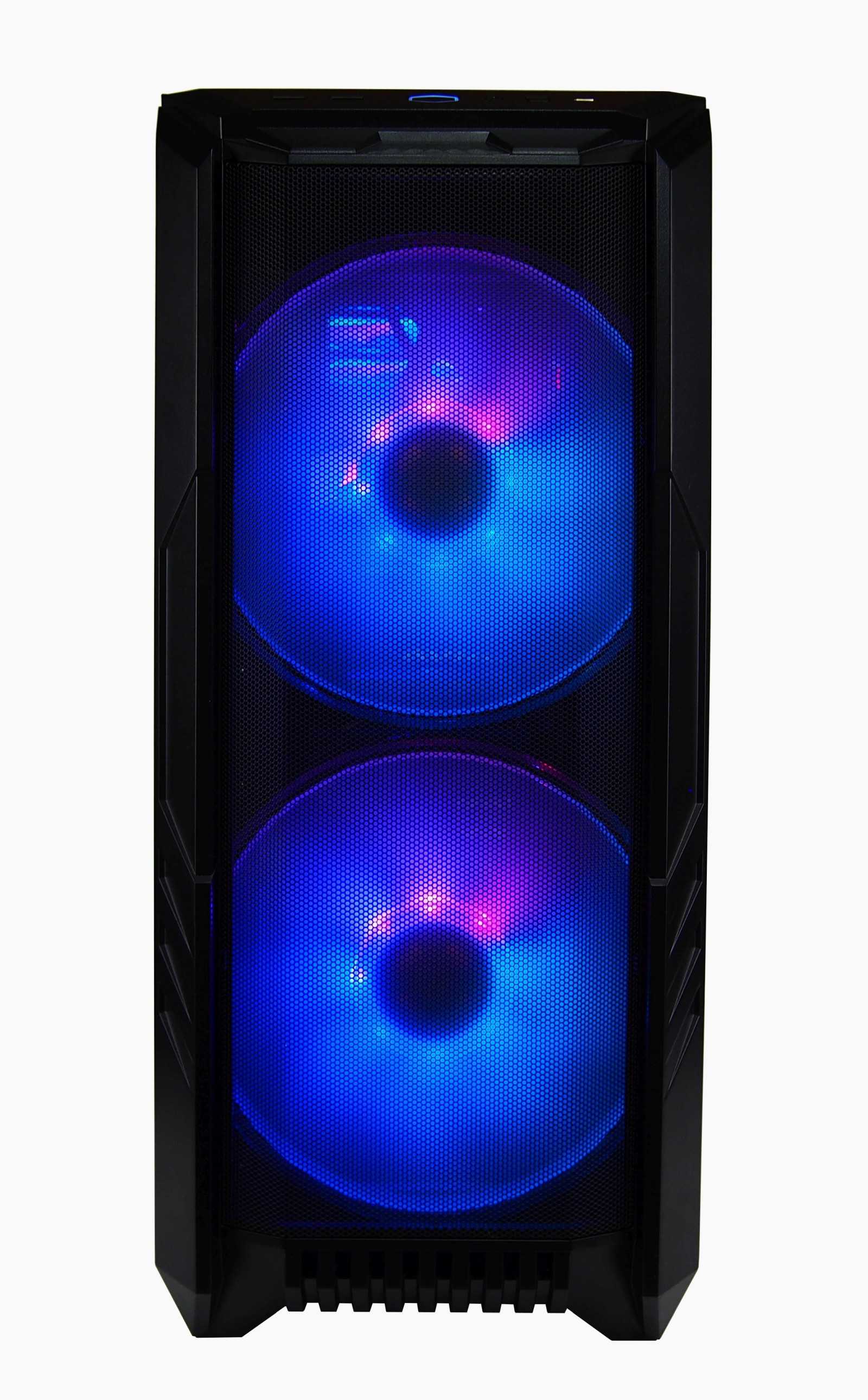
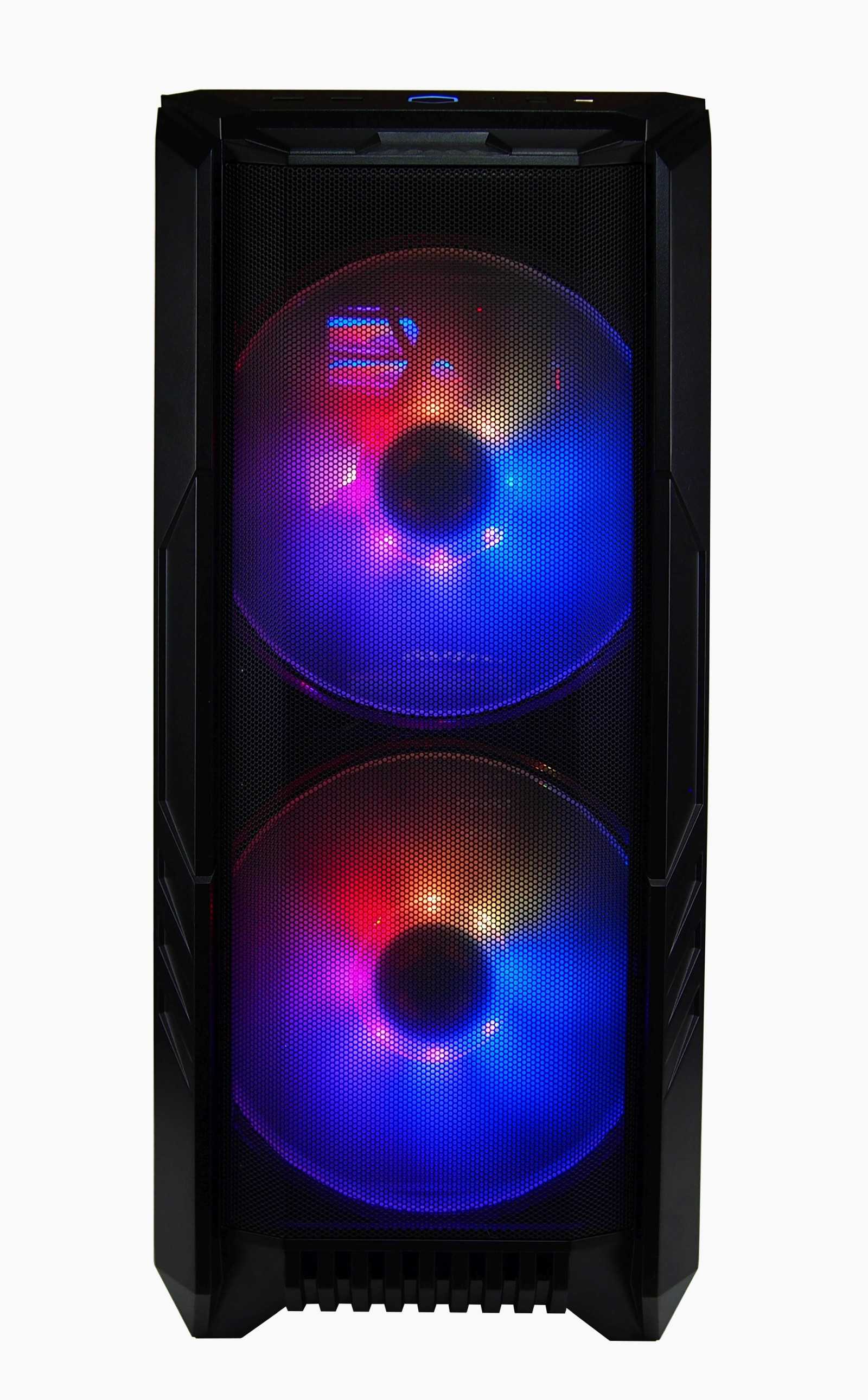
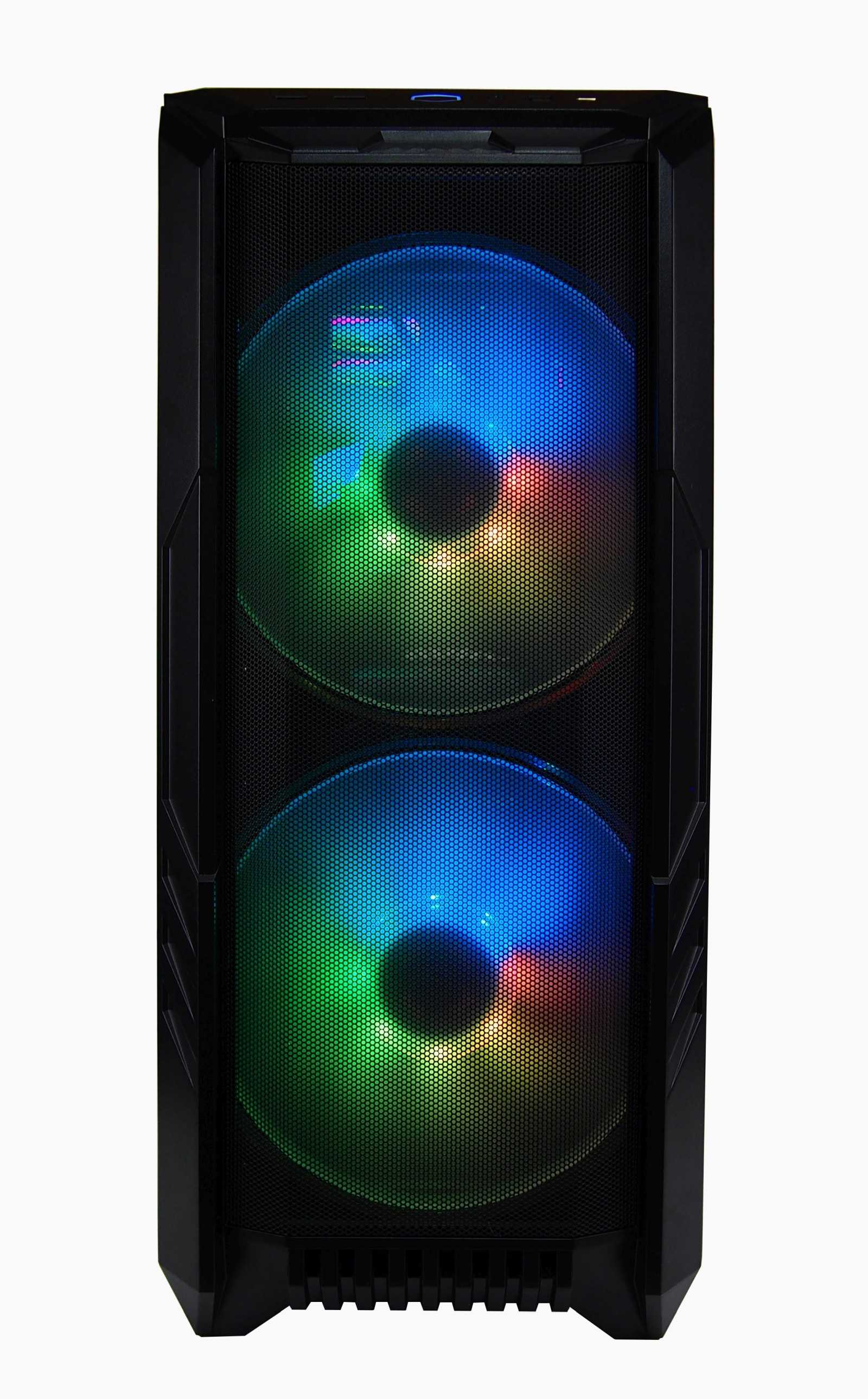
Testing the HAF 500: In the Air Tonight (and Today)
In terms of size, the silent-running-oriented SilverStone Seta Q1 is the closest match to the HAF 500 among recently reviewed cases, yet the Cooler Master’s airflow stands out in our CPU temperature chart. The rivals will likely swap places in noise tests, but by how much?
Voltage-regulator temperature comparisons aren’t quite fair in this situation, because we mounted the cooler in an optimal position for regulator cooling in the HAF 500. While the Seta Q1 is capable of holding our iCUE H100 RGB Pro XT cooler in the same place, putting it there would have required removal of its standard top-panel noise baffle, which would have blown away a big reason for getting that SilverStone case in the first place.
The scale of benefit for the HAF 500’s internal GPU cooling fan is hard to determine, since the tiny Lian Li A4-H20 is closest to achieving its low GPU temperature. Since it’s designed for optimal noise reduction, excessive internal temperatures likely contributed to the Seta Q1’s significant loss here.
Surprisingly, the closed HAF 500’s measured noise level was higher from the non-GPU side than the GPU side. We’ll credit its glass side panel for reflecting some noise from that angle, as removing those panels returned the expected result of the side with the graphics card being louder. We should also note that we heard an audible drone from the right side’s thin steel panel, which makes sense when we consider that even with the glass side, the entire unit weighs less than its rated 21 pounds. There’s very little noise isolation overall when the HAF 500 is closed, since its design focuses on airflow without regard to noise.
For comparison, the SilverStone Seta Q1 was much quieter, though even its noise-reducing design wasn’t close to silent. Conversely, the A4-H2O’s right side panel vents were placed right next to its graphics card. The best thing we can say about any of these cases regarding noise is that users shouldn’t expect their systems to be as raucous as ours under real-world conditions, as most will choose automatic fan control rather than manually setting their fans to maximum RPM.
Inside the MasterCase H500P
After first tilting the plastic cover, it is then able to be lifted up and then released from the chassis. The front I/O panel and wires are attached to the frame of the case, and the 200mm fans mount to the face of the front panel of steel. Other fans have a rail system set further back into the case so that fans can stay on this side, with steel between it and a radiator.
Even with both side panels removed, we cannot see through the interior as of yet. However, the H500P is open from front to back, with only the PSU cover at the bottom putting a hard barrier into the vast open space. We also find that the wires are run through the grommet, and are bundled together and tied off to help prevent damage.
Inside of the front panel of the case, we can see the inset between where the 200mm fans are, and where optional cooling can be installed. As it sits now, there is no support for the third 120 or 140mm fan, but this is included in the hardware.
The top cover must be lifted up at the back to release a series of tabs, and then it can be pulled away from the front I/O panel to remove it. Under the cover, we find a removable raised section of steel, which supplies room for fans and or radiators. It is removable to make installation easier, sure but is also removable if you want to use 200mm fans, with the holes marked 20F.
The motherboard tray offers seven holes to manage wires, the larger three of which have grommets. There are eleven tie points in view at this time, the standoff locations are all marked for compatibility, and on the right, there is a plate to cover wires and also can be used instead of the grommets for wire management, as you will see later.
The PSU cover is a two-piece design and is made this way so that the front part of the cover can be slid back to make room for thicker cooling options in the front. On top of the back section, there are two 2.5″ drive trays mounted to it, while the side of it displays the Cooler Master logo.
Building in the HAF 500
The HAF 500 comes with a manual, tear-open screw pack and several cable ties. Unusual items in the screw pack include a Phillips #2 to socket adapter for repositioning motherboard standoffs, plus eight screw-in pins that allow for the push-mounting of solid-state drives to the back of the motherboard tray.
Front-panel cable connectors include a power button/LED group, HD Audio, a Gen 1-type cable for USB 3 Type-A ports, and a Gen 2 cable for the USB-C 3.2 port. The reset button’s lead is separate, since it was repositioned to serve as a mode selector for the RGB controller.
(Photo: Molly Flores)
Leads from the RGB controller include SATA-style power, motherboard RGB, and motherboard PWM for centralized fan control. The controller itself can act as a passive RGB hub when receiving a signal from a motherboard RGB header.
(Photo: Molly Flores)
The HAF 500’s relatively cavernous interior swallowed our full ATX build with room to spare, with its internal GPU cooling fan positioned almost vertically without hitting our GeForce RTX 2070 graphics card.
Photo: Thomas Soderstrom
The finished build appears resplendent in rainbow mode, though of course you can configure it otherwise.
(Photo: Thomas Soderstrom)
We’re still using the highly rated FSP Dagger Pro 850W power supply in our test builds, thanks to this SFX unit’s inclusion of a PS/2 (full ATX) adapter plate and long cables. Corsair provides the cooling with its iCUE H100i RGB Pro XT closed loop, while remaining hardware is pooled from previous review samples.
Glass and Steel, But Is It a Deal?
The HAF 500 enclosure combines a tempered-glass panel on the left side with a painted steel sheet on the right, plus a mesh face panel up front. That last item covers two oversize 200mm intake fans that reinforce the airflow concept with bold presence.
(Photo: Molly Flores)
A top that’s almost entirely open and covered in a mesh sheet further conveys the max-airflow message, while a front panel at the leading edge of the top panel adds the convenience of a USB 3.2 Gen 2 Type-C port in addition to dual USB 3.2 Gen 1 Type-A ports.
Cooler Master repurposes the front-panel reset button as a mode selector for this model’s RGB controller, surrounds the power button with an LED power-on indicator ring, hides the drive-activity LED behind a pinhole, and reduces front-panel audio connectors to a single combo jack. While we’ve always liked the idea of combo jacks, the fact remains that no splitter cable is included to support the double headphone/mic connectors of our legacy gaming headsets. Hmm. Perhaps our new headsets should come with a splitter to fit legacy cases instead!
Similar Products
(Photo: Molly Flores)
Nothing about the HAF 500’s rear panel is exceptional in terms of airflow, though it does have vented PCI Express slot covers. The fan mount accommodates only 120mm parts, with no provisions for a 140mm fan, and the double-pattern power supply mount allows users to flip their PSUs whichever way they feel will provide the best airflow, fan up or fan down.
(Photo: Molly Flore)
The bottom panel includes a power-supply dust filter that slides out from the back and various mounting points that could be used to place water cooling accessories where the integrated drive cage resides in the default configuration.
(Photo: Thomas Soderstrom)
Flipping the case over and removing the top filter sheet, you’ll find slotted mounts for up to three 120mm or two 140mm fans, along with fixed mounting points for two 200mm fans. The panel clears the top of a motherboard by approximately 57mm, with additional horizontal motherboard clearance of 25mm for 280mm radiators and 45mm for 240mm or 360mm radiators.
An image in our copy of the user manual appeared to show a snap-off side panel, but the online version doesn’t have this. And that’s good, because the panel is actually secured with flat barbed tabs that must be individually unlatched to remove the panel without damage.
(Photo: Thomas Soderstrom)
The two 200mm fans can be removed to fit a front panel radiator up to 3x120mm (a.k.a. 360mm), thanks to a bunch of alternative mounting points on the steel panel behind them.
(Photo: Thomas Soderstrom)
Inside are a removable cable-concealment panel with about 11.3 inches (288mm) of motherboard clearance when installed, a slide-out power supply bay cover, and a drive cage with two 3.5-inch/2.5-inch combo trays within and a 120mm adjustable-angle fan on top. Removing the cable cover permits motherboards well beyond the 13-inch maximum of Extended ATX (EATX), but the HAF 500 doesn’t have provisions for the extra standoffs that would be required to keep an extra-deep motherboard fully stable.
(Photo: Molly Flores)
Angling the fan upward provides 68mm of radiator clearance in front of the drive cage, and sliding the power bay cover forward allows it to be lifted away. Given that the power supply mount is a full 260mm behind the drive bay, Cooler Master’s suggestion of a maximum 180mm power supply depth appears a safe underestimation.
(Photo: Molly Flores)
The drive cage’s two trays provide screw fittings for 2.5-inch drives and side pins for 3.5-inch drives, the pins damped by rubber fittings.
Behind the motherboard tray are eight mounting points to support two 2.5-inch drives, as well as an RGB controller with a powered fan hub. We can also see six cable passages in front of most motherboards, three of which are concealed from view by the cable cover mentioned above. The three non-concealed passages are lined with rubber grommets.
(Photo: Molly Flores)
While the HAF 500’s reset button is repurposed for use as an RGB mode button, the ability of the RGB controller to receive its commands from a motherboard RGB header means that some users might want to reposition the reset lead to serve its usual function. The circuit board hosts up to five RGB devices and four fans, with fan control provided by yet another motherboard lead.
(Photo: Molly Flores)
As for the case dimensions, Cooler Master provides full measurements that actually include protruding hardware (rear panel screws) in its specifications, which we verified at 20.1 by 8.8 by 20.3 inches (HWD). This is truth in advertising that we’d love to see from its competitors.
Inside the MasterCase H500P Continued
The 3-pin powered fan at the back of the H500P is black, although an RGB fan put here instead would have been nice. All of the expansion slot covers are held in place with hex-head screws, and if you plan to use the vertical slots, Cooler Master advises to do so with the support of a bracket, which is optional. As is the extender cable to connect it.
Behind the motherboard tray, we find that the left third has been covered with a removable steel panel, which will block the view of the front I/O, fan, and any optional wires you see fit to run there. We also see that the back of the motherboard socket is blocked from view, which is the finest details we have seen in a case with the option to have a glass panel on this side too. All of the ugly is hidden.
Removing the panels, we find that to the left of the motherboard tray is left wide open. This means that anywhere wires need to go, they can, and you have much less to worry about with wire management, as you can tuck gobs of wires between the two panels which cover this area. On the right, we find a large CPU cooler access hole and is wide enough to accommodate E-ATX motherboard too.
As the case is shipped, the HDD cage is accessible from the left side, and you need to remove the PSU cover to remove either of the two 2.5″ or 3.5″ drive trays. However, there is a second option, and by flipping the side rails, you can access the drives from the back.
The PSU goes in the back of the chassis and rests on four rubber pads on top of steel bumps shaped into the floor. There is hexagonal mesh for the PSU to draw through, and to install the PSU, the cover has to be removed to do so as the height left here will not allow the PSU to slide in from the back.
There is a lot of wires coming from the fans and the front I/O panel. We find 3-pin female plugs to power the fans, and 3-pin male plus to attach three fans. One 4-pin RGB connection hits a splitter and allows three devices to be connected to it, and that is one beyond the two used by the fans. We also see the native USB 3.0 connection, one for USB 2.0, and one for HD Audio. At the top, we find the leads from the buttons and LEDs, and all of the wires are black, so they blend in.
Hardware & Documentation
Cooler Master is sure to provide you with all of the screws and such to allow the H500P to be filled completely. There are long fan screws to use with optional 200mm fans at the top of the case, a socket and seven standoffs, and a set of eight screws for standard fan installation. At the bottom, the hex-head screws are used to mount the PSU and the motherboard, the smaller M3 screws are for 2.5″ drive mounting, and the two longer 6-32 screws lock the HDD trays into the cage.
If you want to remove the front fans in favor of three 120mm or 140mm fans, you will need the bracket seen here. This can be screwed into the chassis with the extra hex-head screws, allowing the third fan to fit securely without vibration. There are ten zip-ties to help with wire management, and Cooler Master also supplied a 4-pin PATA connector to power the front fans with if motherboard fan headers are in short supply.
More to clean the tempered glass panel than for anything else, Cooler Master supplied a microfiber cloth with their logo on it. We would not advise using this on the plastic unless it has been rinsed off first and let to dry. The muck from the air could be picked up by this cloth and eventually lead to scratches on the front and top panels.
The H500P user manual is not as involved as we have seen in previously submitted Cooler Master Cases. There is a parts list, which is good, and there are renderings for the build process; great. There is very little text to explain the images, and there are no images of fan placement or radiator compatibility. The warranty information discusses what Cooler Master will cover for the term of two-years from the date of purchase.
Особенности сборки
Благодаря вместительности HAF 500, собрать в этом корпусе игровую сборку с 360-мм водянкой можно быстро и аккуратно. Достаточная по глубине ниша для размещения кабелей позволяет расположить их скрытно. Удобные ушки на межсекционной стенке позволяют зафиксировать провода и наладить порядок.
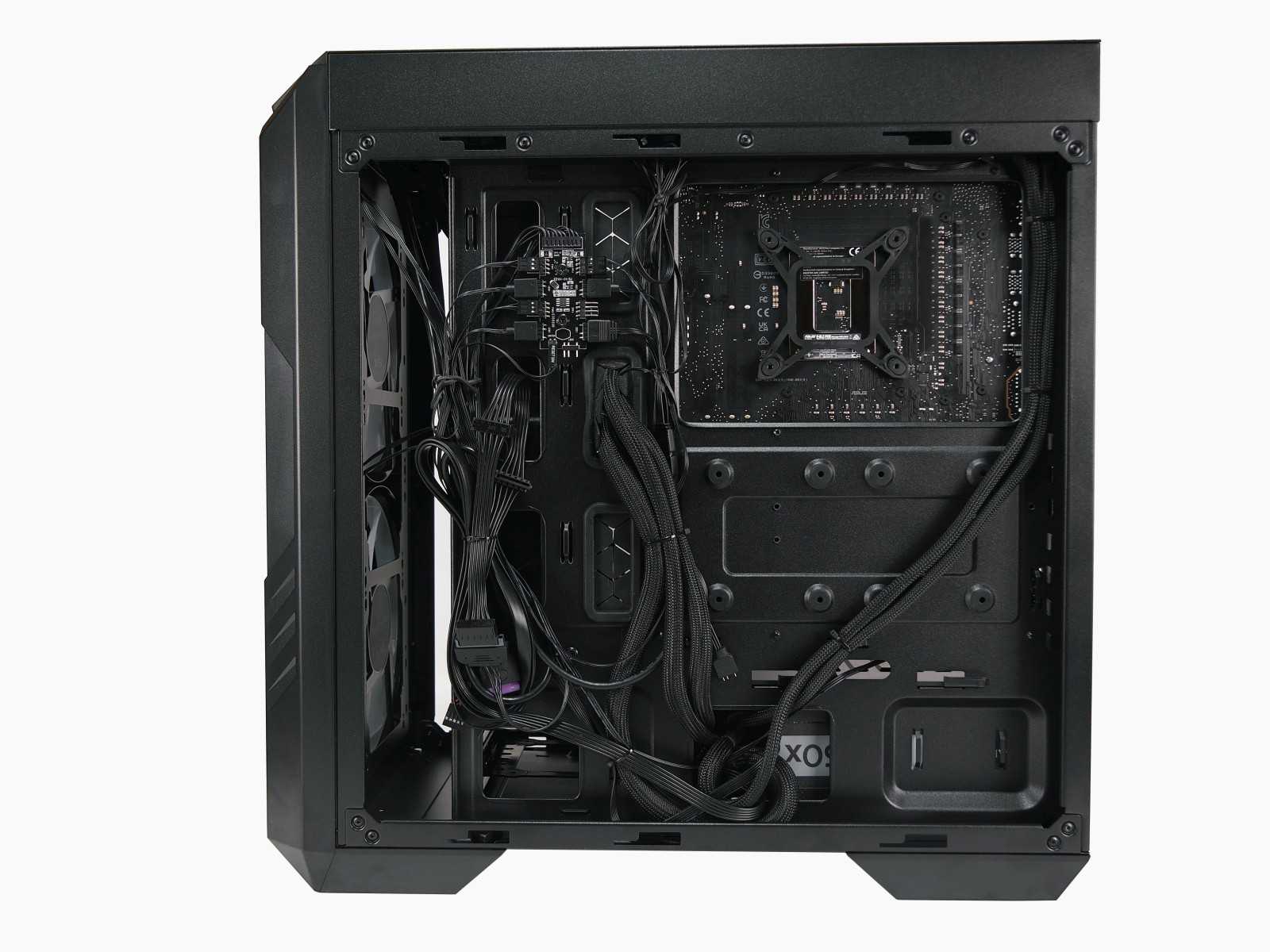

Итоговый результат сборки в рабочем состоянии выглядит следующим образом. Стоит отметить сразу хорошую видимость комплектующих за счет вентиляторов с ARGB подсветкой. С ее синхронизацией отлично справляется фирменный контроллер корпуса.
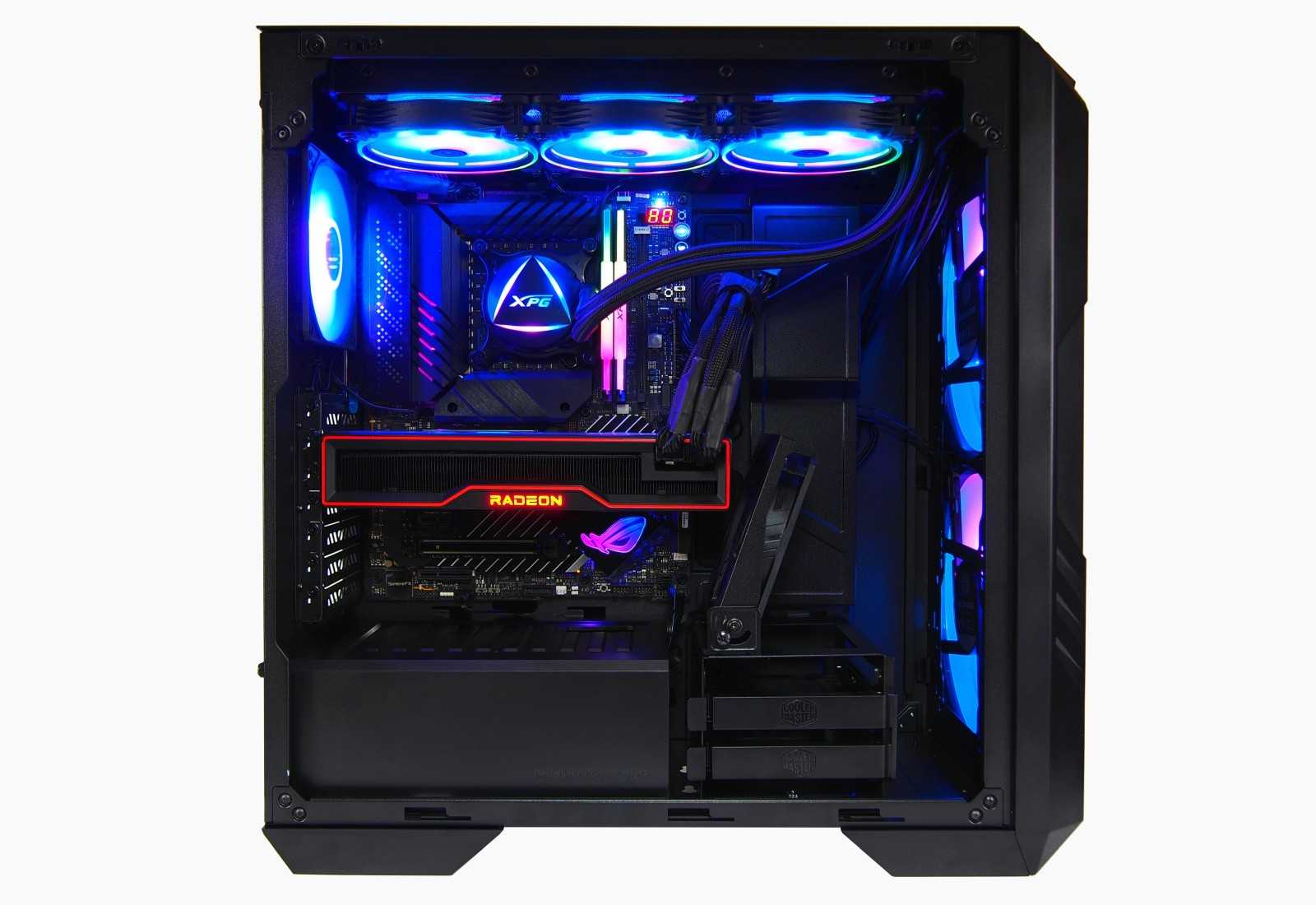
А так выглядит установленный наверх 360-мм радиатор СЖО, пространства для которого достаточно в HAF 500, чтобы не конфликтовать с материнской платой.
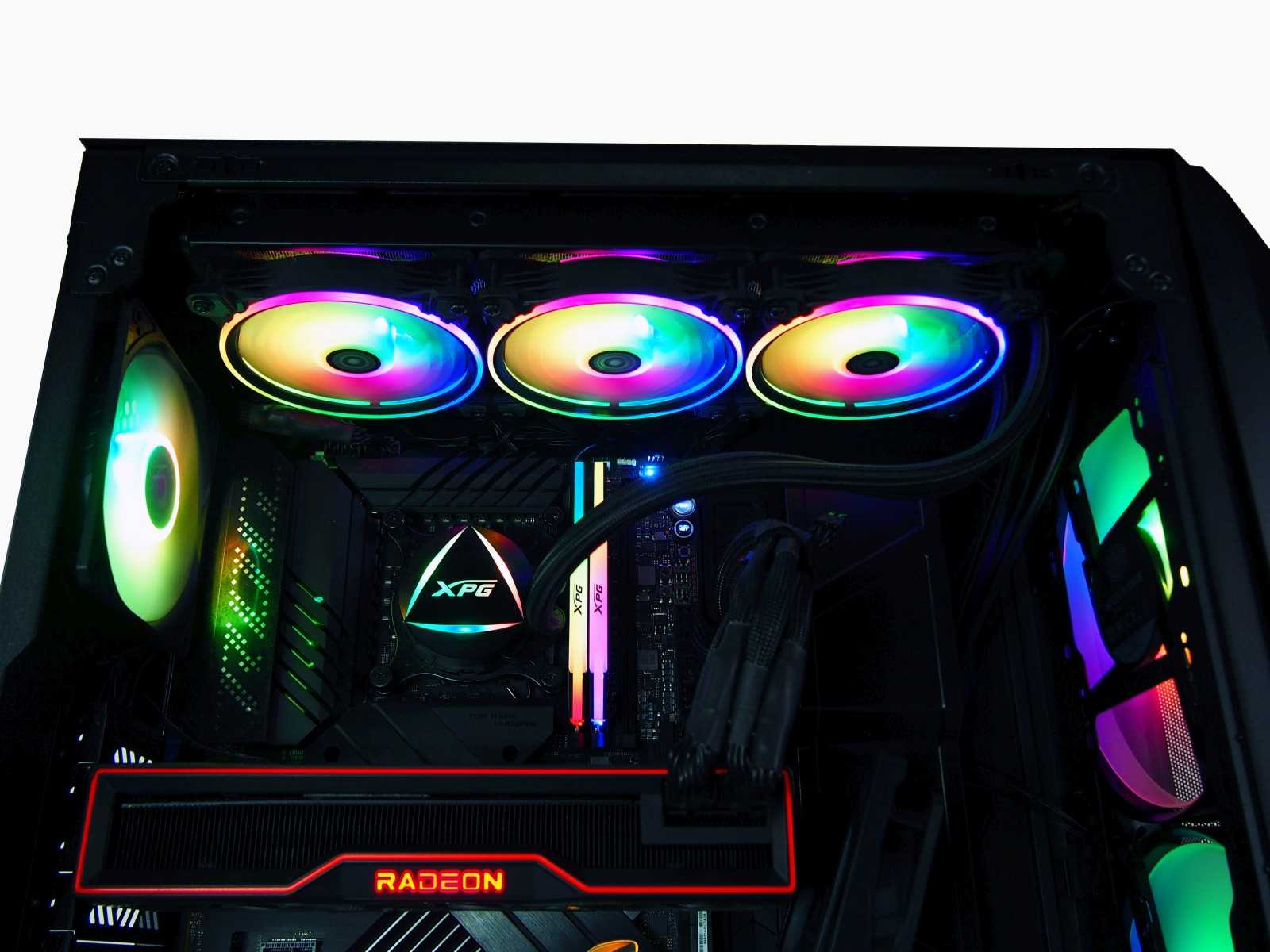
То же самое можно сказать и про 120-мм вентилятор, установленный на тыльную стенку корпуса.
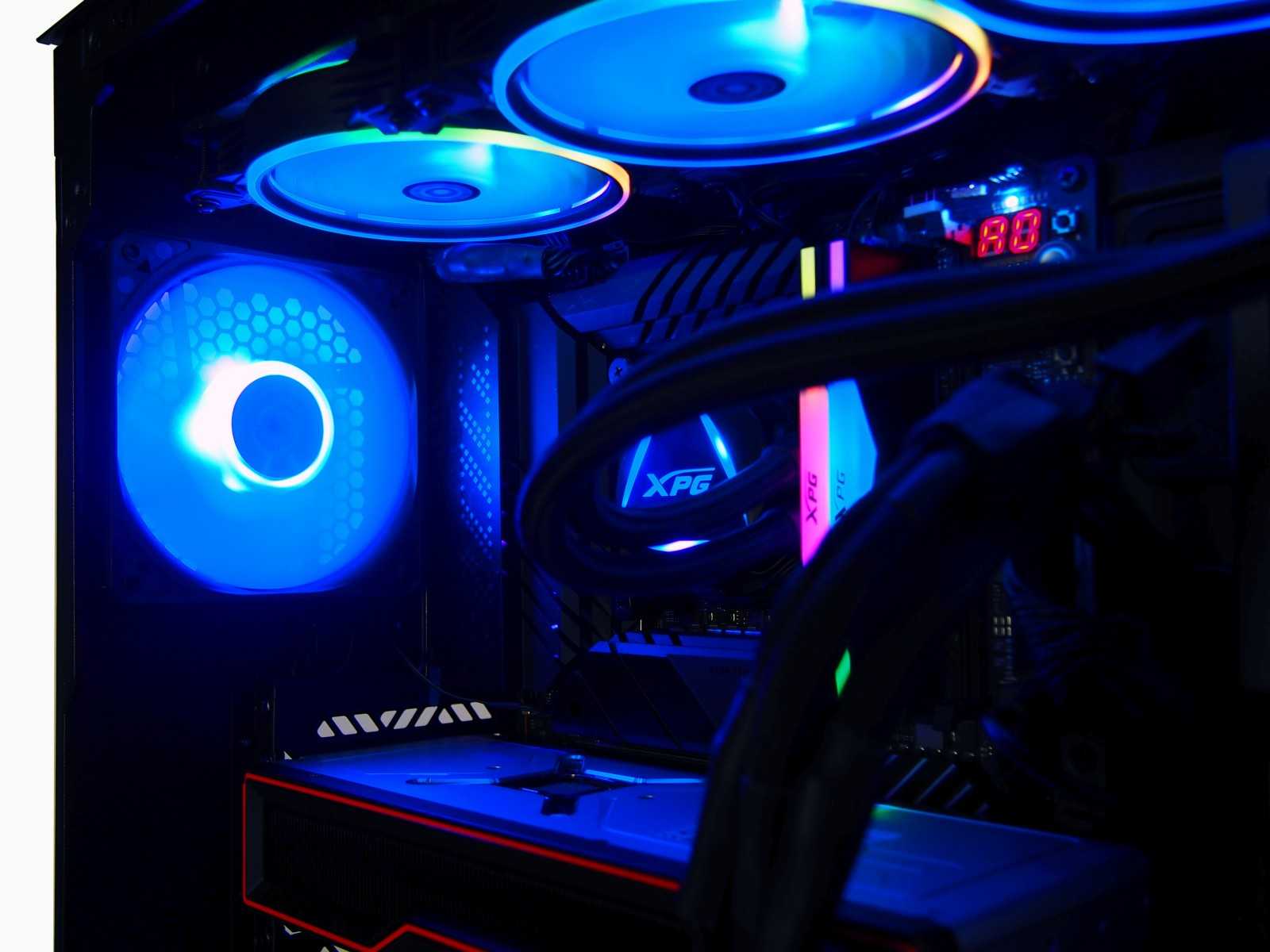
Конструкция снаружи и внутри
Сразу после распаковки HAF 500 кажется большим, но точно не огромным. По габаритам 516 х 224 х 510 мм в глубину, ширину и высоту данный кейс можно считать обычным Mid Tower. На это указывает и поддерживаемый для установки форм-фактор материнских плат. HAF 500 может принять на борт ATX, Micro-ATX и Mini-ITX платы.
Главная боковая панель HAF 500 выполнена из закаленного стекла с тонировкой. Другая стенка корпуса сделана из цельного листа металла. Вся конструкция выполнена в строгом черном цвете.
Визитной карточкой HAF 500 является передняя сетчатая панель, за которой установлены два 200-мм вентилятора с ARGB-подсветкой. С таким подходом этот кейс сразу претендует на хорошую продуваемость внутреннего пространства. Используемые вертушки рассчитаны на максимальную скорость вращения 800 об/мин, что позволяет надеяться на акустический комфорт. На тыльной стороне HAF 500 для вывода нагретого воздуха установлена одна 120-мм вертушка SickleFlow PWM. Она также оборудована адресуемой RGB-подсветкой для лучшей визуализации внутреннего пространства.
Кнопки управления и разъемы сосредоточены на верхней панели в передней части кейса. Здесь пользователь обнаружит:
- два разъема USB 3.2 Gen1;
- один разъем USB 3.2 Gen1 Type-C;
- один разъем 3.5 мм для гарнитуры;
- кнопку Power с подсветкой;
- кнопку Reset.
Что же касается непосредственно верхней панели, то она выполнена сетчатой и имеет точки крепления для корпусных вентиляторов и радиатора СЖО. Сверху панель покрывает антипылевый фильтр с магнитной рамкой.
Донная часть HAF 500 также оборудована антипылевым фильтром. Он установлен в месте посадки блока питания. Для устойчивого положения на рабочей поверхности конструкция кейса предусматривает четыре опоры с резиновыми платформами.
Оба фильтра на HAF 500 быстросъемные, что делает их очистку от пыли нетрудоемким занятием. Фильтры можно продувать или мыть в теплой воде.
Открыв боковую крышку корпуса, можно оценить конструкцию кейса и организацию кабелей. Их у HAF 500 немало, учитывая множество кнопок и разъемов на панели кейса, а также три корпусных вентилятора с подсветкой.
Помогает управлять вертушками и ARGB подсветкой фирменный контроллер, установленный на межсекционную стенку корпуса. Он рассчитан на четыре вентилятора с разъемами 4-пин PWM, а также на пять элементов подсветки с разъемом +5В RGB. Питание контроллера реализовано с помощью кабеля с 15-контактным разъемом SATA. Для подключения фронтальных кнопок управления и разъемов корпуса используется набор кабелей, продемонстрированных на фото ниже.
А так выглядит внутреннее пространство HAF 500, вместительности которого будет достаточно для продвинутой игровой сборки. Корпус рассчитан на установку башенных кулеров высотой до 167 мм и графических адаптеров длиной до 410 мм.
По умолчанию HAF 500 поддерживает блоки питания ATX длиной до 180 мм. Место для установки источника питания скрыто под пластиковым кожухом. Но если демонтировать съемную корзину в передней части кейса, то в HAF 500 можно установить блок питания практически любой длины.
На корзину для накопителей установлен 120-мм вентилятор SickleFlow PWM на поворотном кронштейне. Это своеобразная фирменная фича HAF 500, призванная бороться с высоким тепловыделением современных графических адаптеров. Благодаря поворотному кронштейну пользователь может менять угол наклона, регулируя таким образом направление воздушного потока.
Корзина для накопителей включает в себя два пластиковых контейнера для пары 3.5″ или 2.5″ дисков. Еще два 2.5″ накопителя могут быть установлены на межсекционную стенку с внутренней стороны.
Если корзину для накопителей демонтировать, то, как уже говорилось выше, это снимет все ограничения на длину устанавливаемого блока питания. И в то же время позволит установить на переднюю стенку HAF 500 толстостенный радиатор СЖО кастомного типа. Достаточно аккуратно и продуманно выполнены на HAF 500 отверстия для протяжки кабелей. Предусмотрен ряд резиновых прокладок и декоративная панель, прикрывающая возможное кабельное безобразие.
Для укладки кабелей HAF 500 предлагает нишу глубиной в 25 мм. Верхняя часть корпуса оставляет запас для установки стандартной СЖО с 30 мм радиатором и 25 мм вертушками.
Final Thoughts
Hitting on all of the good things about the MasterCase H500P is a long list, but here goes. The appearance is the first thing that strikes you, and why some may not like it, we find it very aesthetically pleasing. The mix of gunmetal grey with black, the clear windows at the top and the front, side panel made of tempered glass that is easy to use, and an option to get a second one later; it ticks all the boxes. Internally, there is just enough room for drives for many users, but if you do find a need for more drive bays, the 2.5″ drive trays will be available to get, just like the glass panel. If you are looking for 5.2″ drive bays, there are none offered out of the box, but again, Cooler Master intends to offer those too.
The roomy interior allows for a ton of airflow through the case, and it can be felt and seen in our better than usual thermal results we got while inside of this case. Of course, there is the dual-part PSU cover which has its tricks, but what takes the cake for us are the two covers used to hide all of the wiring. With a steel panel in place, it is overkill, but if you like glass on both sides, that is when the panels make their biggest mark. We also like that with the fans at full power, from a meter away, it is nearly inaudible, and we have to get closer than a foot from the chassis to cross the 30dB barrier. With all of that being said, we are surely leaving things out, but we feel you get the points that Cooler Master has upped the MasterCase lineup, and this H500P is the best of them all.
With all of the layers of fan support brackets, covers, windows, bits of mesh, and with our components installed, we were a little taken back that not a single thing rattles. The components of the front bezel lock into place well and do not feel loose in any way. However, rather than straight alignment tabs, we do wish the top panel has clips of some sort too. When it came to moving the case, any time we touched the top panel, it came loose and was constantly needed to be reattached. The reality of it all is that the top panel’s fitment is our only complaint. With everything stripped from the chassis, it is strong and ready for any twists and turns, and in no way feels cheap or flimsy. There is much to take in, as the MasterCase H500P offers a ton of features, modularity, and options to enhance it down the line. It is rare that a company can build one great chassis a year, but after seeing the Cosmos, and now this, we feel Cooler Master has upped their game and intended to change the way we see the chassis market.
Some could argue that Cooler Master should have included USB 3.1 Type-C for this price and that it is the future, but we say with all the adapters available, we feel that many can get by without it. What Cooler Master can deliver does explain much of the price tag, and to us, we do not feel they are out of line near the $150 mark for a mid-tower chassis. You are going to see one of the most well build designs with options you never knew you needed until you had them.
The MasterCase H500P is a chassis that many will soon replicate is some form or fashion, and we know the wire management plates will start to show in many tempered glass cases. If imitation is the sincerest form of flattery, which means that the MasterCase H500P is that damn good. All other case makers should pay attention, as the H500P is the new bar to hit in any form factor chassis design.
Chad’s Chassis Test System Specifications
- Motherboard: ASUS Maximus IX Code Z270 (buy from Amazon)
- CPU: Intel Core i7 7700K (buy from Amazon)
- Cooler: NZXT Kraken X62 (buy from Amazon)
- Memory: Team T-Force Night Hawk RGB TF1D48G3000HC16CBK
- Video Card: NVIDIA GeForce GTX 980 (buy from Amazon)
- Storage: Samsung XP941 256GB (buy from Amazon)
- Power Supply: SilverStone SST-ST85F-G (buy from Amazon)
- OS: Microsoft Windows 10 Home 64-bit (buy from Amazon)
Packaging
With the traditional purple accents on a black box, we see that this MasterCase H500P is delivered in the same. A large image of the chassis is present, shifted to the right of center, and there is an RGB icon in the bottom-right corner too. We also see that there is a mention of the 200mm fans used, which you see in the image above it.
Had FedEx chose another location for the sticker, on this purple panel, we would have seen an unimpeded view of the front of the chassis. With what we can see, we do find many details that fit this case well into the MasterCase lineup.
With the company name, logo, motto, and the product name at the top, Cooler Master then jumps into why this case was made, and why it should appeal to you. Next to that is a much smaller image of the case than we have seen so far, and the bottom half of the panel is used to display five key features of the H500P and is presented in eight languages.
The second thin panel is also purple, but this time, it is used to display the specifications. The chart we used from the reviewer’s guide has more detail, but the majority of that information discussed earlier is present here as well.
We normally do not take an image of the initial unboxing, but opening the H500P told us something different was going on. The hardware is presented in a black box, which is easy to locate for later use, and with the gray handles laying across the foam, we had to tug on them to see what happened.
By lifting up on the cloth handles, the entire chassis, inner packaging and all, come easily out of the box. The gray bag has the cooler master logo on it and does make a convenient way to travel with the chassis after it is built as well.
Inside of the bag, we find the chassis has plastic clinging to the front and the top of the case, and at that point, the entire chassis is surrounded with a plastic liner. To take the shock of bumps along the way to your door, thick Styrofoam caps are used. Attention to detail is key with packaging, and in no way was our MasterCase H500P deformed or distressed in any form.
Внешний вид и характеристики
Корпус поставляется в красочной картонной коробке. Внутри нее –сумка с ручками, в которой и находится корпус. Интересное решение, но не являющееся чем-то новым. В истории компании Cooler Master уже встречались корпуса, которые также поставлялись, упакованными в такую сумку.
Помимо самого H500P в комплект входят руководство, набор винтов, адаптер и кронштейн для вентилятора, несколько стяжек и тряпочка для протирки. В общем, ничего лишнего, но и ненужного тоже нет. Все по делу.
Основные характеристики:
| Тип корпуса | Midi Tower |
| Размеры, мм | 544x242x542 |
| Материалыизготовления | Сталь, пластик, закаленное стекло |
| Цвет | Черный |
| Вес, кг | 11.3 |
| Кнопки и разъемы на фронтальной панели | Power, reset, 2xUSB 3.0, 2xUSB 2.0, разъемдлянаушников, разъем для микрофона |
| Отсеки для накопителей | 2 x 3.5″/2.5″, 2 x 2.5″ |
| Поддерживаемые материнские платы | E-ATX, ATX, micro-ATX, mini-ITX |
| Охлаждение | 3 x 140 или 120 мм/2 х 200 мм фронтальные вентиляторы (2 x200 мм установлены изначально),
1 x 140 мм/120 мм задний вентилятор (1 x 140 мм установлен изначально), 3 x 140 или 120 мм/2 х 200 мм на верхней крышке |
| Допустимая высота процессорного кулера, мм | 190 |
| Максимальная длина видеокарты, мм | 412 |
| Пылевые фильтры | Съемные |
Что сразу бросается в глаза при виде этой модели? Конечно, два огромных вентилятора под стеклянной передней панелью. Кто-то еще сомневается, что перед нами представитель линейки HAF (High AirFlow) корпусов этого производителя? Это действительно удачная серия, насчитывающая немало моделей. H500P – еще одна из них.
Отличительной чертой именно этой серии корпусов является отличное охлаждение, что позволяет собрать очень мощный компьютер. Причем доступно не только воздушное охлаждение. В верхнюю панель и фронтальную стенку можно установить радиаторы жидкостного охлаждения размером 360 мм и толщиной до 55 мм.
Оба этих солидных «карлсона» закрыты довольно симпатичной передней панелью, стеклянной, с вертикальными гранями и металлической окантовкой. Анфас смотрится хорошо, а вот если сместить точку зрения немного вбок, то сразу становятся видны практически незаметные до этого боковые прорези для прохождения воздуха с крупными ячейками трапецеидальной формы.
Вот лично у меня сразу возникают ассоциации с вязью каркаса башенного крана или мачты ЛЭП. Хорошо хоть и на верхней панели сделаны такие же прорези, что хоть как-то продолжает дизайнерский замысел. Это, конечно, субъективное мнение, но решение все же спорное, на мой взгляд. Зато не мешающее охлаждению.
Ну а закрывает передняя стенка два 200-мм вентилятора. С подсветкой? Да побойтесь бога, 2017-й год же к концу идет. Конечно же да! Хотя никакого контроллера, как, например, у корпуса Cosmos C700P, не предусмотрено. Просто подключаете 4-пиновый разъем к соответствующему разъему материнской платы и наслаждаетесь красивым красным свечением.
Хотите другой цвет? Пожалуйста, но управлять световыми эффектами придется либо с отдельного контроллера, либо через материнскую плату.
Боковая стенка, закрывающая материнскую плату, из закаленного стекла, другая стенка – полностью металлическая. Открывается стеклянная стенка очень просто, достаточно повернуть единственный винт, находящийся сверху, после чего вся дверца легко вытаскивается.
Задняя стенка – элемент, до которого изыски дизайна пока что не добрались. Традиционный вид разбавляет разве что пара прорезей, которые понадобятся при вертикальной установке видеокарты, благо ширина корпуса это позволяет. Похожее решение есть и на других моделях, например, на том же Cosmos C700P.
Вытяжной вентилятор крепится к стенке в прорези, позволяющие перемещать его по вертикали, чтобы расположить напротив процессорного кулера. Кстати, по аналогичным прорезям-направляющим можно перемещать и вентиляторы при установке их на верхней поверхности. Удобно.
Фронтальная панель – классика, в смысле находящихся на ней разъемов и кнопок. Никаких тут HDMI или USB Type-C, что, впрочем, жаль, т. к. это, похоже, становится уже признаком хорошего тона в современных моделях. По крайне мере, два разъема USB 2.0 выглядят уже анахронизмом.
Характеристики
| Модель | Cooler Master HAF 500 |
| Тип корпуса | Mid Tower |
| Габариты (ДхШхВ) | 516*224*510 мм |
| Вес | 9.5 кг |
| Боковые панели | Стекло + сталь |
| Материал | Сталь + стекло + пластик |
| Посадочные места для накопителей | Места накопителей: 2*2.5” + 2*3.5”(или 2*2.5”) |
| Слоты расширения | 7 |
| Материнские платы | Mini ITX, Micro ATX, ATX |
| Порты вводы/вывода | 2*USB 3.2 Gen1, USB 3.2 Gen2 Type-C, HD Audio |
| Максимальная высота системы охлаждения CPU | 167 мм |
| Ограничение длины видеокарты | 410 мм |
| Возможность установки радиаторов | Спереди: 360 мм, 280 мм, 240 мм, 200 мм, 140 мм, 120 мм Сверху: 360 мм, 280 мм, 240 мм, 140 мм, 120 мм Сзади: 120 мм |
Заключение
Cooler Master HAF 500 — добротный корпус для продвинутых игровых сборок, определенно заслуживающий внимания геймеров и энтузиастов. В конструкции этого кейса нам понравились вместительность и удобство сборки, а также продуманная организация кабель-менеджмента. Размеры HAF 500 таковы, что сюда поместится видеокарта и блок питания любой длины, а для любителей жидкостного охлаждения у этого кейса есть пара мест для 360-мм радиаторов. Привлекательным выглядит и оснащение этого корпуса в виде 4-х вентиляторов. Причем последний, с поворотным кронштейном станет настоящей палочкой-выручалочкой для владельцев мощных видеокарт. Единственное, чем может немного огорчить HAF 500 любителей тишины — шумными 200-мм вертушками, установленными на лицевой панели. Зато у этого кейса есть удобные быстросъемные фильтры, а также красивая ARGB подсветка и отличная продуваемость.
Плюсы:
- вместительный для габаритных комплектующих;
- в комплекте четыре вентилятора;
- есть места для установки 360-мм радиаторов СЖО;
- отличная продуваемость внутреннего пространства;
- низкие температуры комплектующих во время нагрузки;
- удобные съемные антипылевые фильтры;
- вентилятор с поворотным кронштейном очень полезен для GPU.
Минусы:
- шумные 200-мм вентиляторы;
- отсутствие в продаже на территории РФ.
Заключение. Cooler Master Mastercase H500P, обзор корпуса с ОГРОМНЫМИ вентиляторами
Иногда так случается, что при знакомстве с той или иной вещью необходимость в тестировании отпадает. Вот и в данном случае, кто-то сомневается, что перегрев даже самым горячим компьютерным комплектующим в этом корпусе не грозит? Передние вентиляторы хотя и крутятся довольно медленно (скорость вращения порядка 800 об/мин), но создают большой воздушный поток, да и работают тихо. Если надо – можно и добавить. Вентиляторов. И не будем забывать, что корпус относится к линейке HAF, так что положение обязывает!
Хвалиться тем, как выглядит собранный компьютер? У каждого своя конфигурация, свой набор компонентов, да и эстетические предпочтения индивидуальны. Если нравится подсветка, а штатный красный цвет не гармонирует с дизайном помещения, то всегда есть возможность изменить его, правда, при помощи материнской платы или специального контроллера.
При сборке надо очень постараться, чтобы умудриться сделать так, чтобы провода торчали наружу. Все продумано хорошо, а к качеству изготовления претензий нет. Все же имя производителя и заработанная репутация основывается именно на тщательном подходе к проектированию и изготовлению своей продукции.
Впрочем, и посетовать есть на что. В первую очередь – это на несколько архаичную фронтальную панель, на которой не нашлось места для USB Type-C и даже простенького контроллера подсветки. Учитывая размер вентиляторов и их низкую частоту вращения, смириться с отсутствием контроллера вентиляторов вполне можно.
Есть претензии и к установке некоторых компонентов, в частности – жестких дисков. Закрывающая их крышка – это неплохо, но для того, чтобы заменить диск или поставить новый, приходится снимать обе боковые стенки, откручивать несколько винтов, снимать кожух… А потом все то же, но в обратной последовательности. Конечно, диски меняются довольно редко, но и корпус того класса, в котором придают значение каждой мелочи.
Корпуса еще в продаже нет, как и точной цены. Ожидается, что его стоимость будет находиться на уровне 180$. Cooler Master Mastercase H500P вполне оправдывает такую цену, хотя лично мне он не очень понравился. Чего-то не хватает…




























